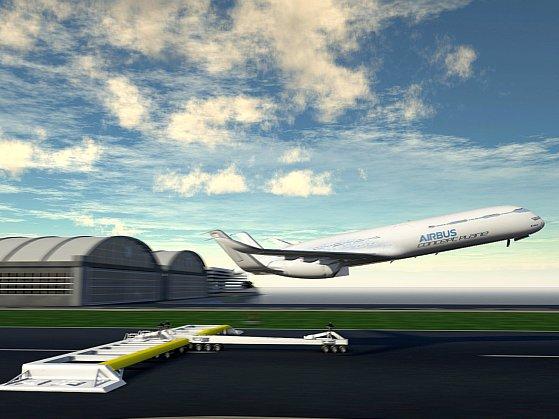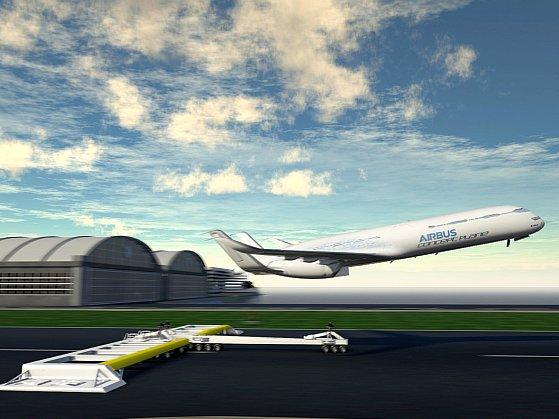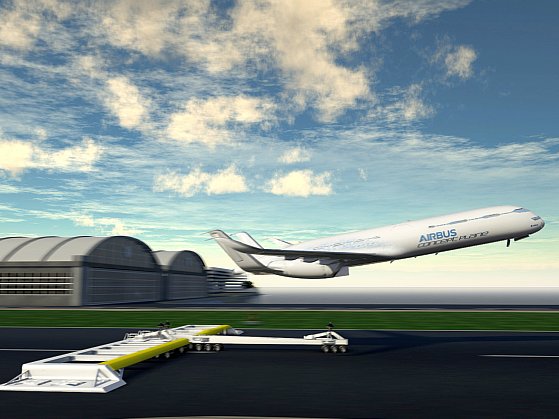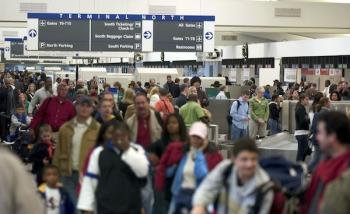Airplane manufacturer Airbus has ignited curiosity in the aviation community by giving a look into the future of aviation. By looking into aviation for 2050 and beyond, for the first time they are taking on the idea of how an aircraft operates on the ground and in the skies is as essential as its design.
Smarter Skies is the ambitious Airbus concept that reveals how air travel might look 40 years from now. It tries to solve some difficult operation challenges the aviation industry faces today and presents brave ideas based on renewable energy sources.
Faced with increased fuel costs, airlines are constantly looking for ways to minimize delays both on the ground and in the air to lower operation costs, and to stay competitive in a global market.
Congested traffic in the air and on the ground prevents airlines from reaching better fuel efficiency. Halts on runways make aircraft run engines inefficiently before takeoff and after landing. It leads not only to greater fuel consumption, but also increases carbon dioxide levels and causes air pollution.
The innovative approach that Airbus applies in its Smarter Skies program aims to target precisely these problems. By providing advanced technological solutions, which may sound futuristic now, Airbus claims it is fully achievable in the not-so-distant future.
Its future course is to reduce waste in the entire operation cycle of the aircraft, from takeoff to landing, the waste in fuel consumption, and the waste in time and in emissions. Smarter Skies uses five simple concepts targeting all stages of air travel: takeoff, time in the air, landing, and on the ground.
Takeoff
Not relying on engine power but on an assisted takeoff system using renewable power is how we might one day soar into the skies, as the first Smarter Skies stage, named Eco-climb, suggests.
With an inductive magnetic circuit within the fuselage itself and electromagnetic tracks on the ground, the airplane will climb quicker and level off much faster at its cruising altitude. It is very similar to the concept employed today in high-speed electromagnetic trains. The fast climb translates to less noise over nearby residential areas and local airports. Lower emissions will also be a byproduct of using less maximum engine thrust.
In the Air
Contrary to some common misunderstandings, airplanes today do not fly as efficiently as they could from point A to point B. They are directed to flight corridors and flight patterns that are often not the shortest way to their destinations. This practice often leads to increased fuel consumption.
Airbus made a test flight from Brussels to Stockholm that took on a straight flight path, avoiding the traditional air corridor used between the two cities. The flight took 20 minutes less than the traditional flight.
Airbus came up with the idea of Express Skyways, which is the second component of the Smarter Skies. The aircrafts are to use advanced 4-D navigational systems that will allow them to make flight formations similar to flocks of birds.
For instance, transatlantic flights from San Francisco, Los Angeles, and Las Vegas bound for the U.K. could meet in the air somewhere over Utah in a formation where the trailing planes can effectively “surf” on the energy coming from the wing tip vortices of the leading aircraft, which will reduce drag, increase fuel efficiency, and minimize engine emissions.
It will also allow air traffic control (ATC) to treat such formations as one unit and be able to streamline its workload. For safety, planes will not be permitted to get too close to each other. Current standards require four nautical miles of separation between airplanes, but the Smarter Skies formation will allow for less than one nautical mile, which will be sufficient to take on the benefits of the flight formation.
Optimized Landing
Counting on an advanced navigational system to determine the best time to leave cruising altitude, the plane can start a continued descent into the airport without the need of holding patterns in the air or use much thrust to maneuver from one altitude to another. This is the vision for this operation. The goal is again to cut emissions and reduce noise during landing, which currently is the key contributing factor in pollution created in and around airports.
When approaching their flight destinations, airplanes leave their cruising altitude and begin their descent, guided by ATC. Busy airports can have multiple planes nearing the airport at the same time, and ATC has to guide them to land safely. The process often requires planes to fly to a lower altitude and then continue to fly at this altitude for a certain time, before they are allowed to go to a lower altitude by ground flight control. It is known as the step down approach.
Smarter Skies avoids the step down approach and introduces a more fuel-efficient descent. It would be achieved only if the plane knows exactly at what time to abandon its cruising altitude and enter its continued, steep descent that will not create any holding patterns or delays in the air. In this scenario, the plane engines will be idle as the aircraft will simply glide down.
On the Ground
Leaving the gate, planes are maneuvered into position to enter runways by human-operated tug vehicles. Imagine the same approach on landing: Only once the plane is on the ground, is it maneuvered to the gate by an autonomous renewable energy-powered tug. At this point, engines will be turned off and not used during taxiing to the gate. It is not quite unimaginable, as Smarter Skies aims to streamline the last step of the flight cycle.
According to the International Air Transport Association, carbon dioxide emissions during taxiing can be reduced up to 6 million tons each year if airplanes simply turn off their engines soon after landing.
If this happens, passengers will be more likely to get off the plane on time, and delays at the gates will be just a memory of the past.
Using vehicles on the runways without human drivers is also not farfetched. Perhaps developing electromagnetic currents passing through rails installed on runways with the aircraft acting as conduit, would allow for this concept to be implemented in the future.
Based on research data, Airbus estimated that flights in the United States and Europe could be reduced by up to 13 minutes, as it could be in other parts of the world. Taking into account the average of 30 million flights a year, the industry could save 9 million tons of fuel or cut carbon dioxide emissions by 28 million tons annually. This would also save 5 million hours of travel time.
“Our engineers are continuously encouraged to think widely and come up with ‘disruptive’ ideas, which will assist our industry in meeting the 2050 targets we have signed up to,” Charles Champion, executive vice president of engineering at Airbus, said in a statement. “These and the other tough environmental targets will only be met by a combination of investment in smarter aircraft design and optimizing the environment in which the aircraft operates. That is why our latest Future by Airbus Smarter Skies concepts focus on not just what we fly but, how we may fly in 2050 and beyond.”
The Epoch Times publishes in 35 countries and in 19 languages. Subscribe to our e-newsletter.





